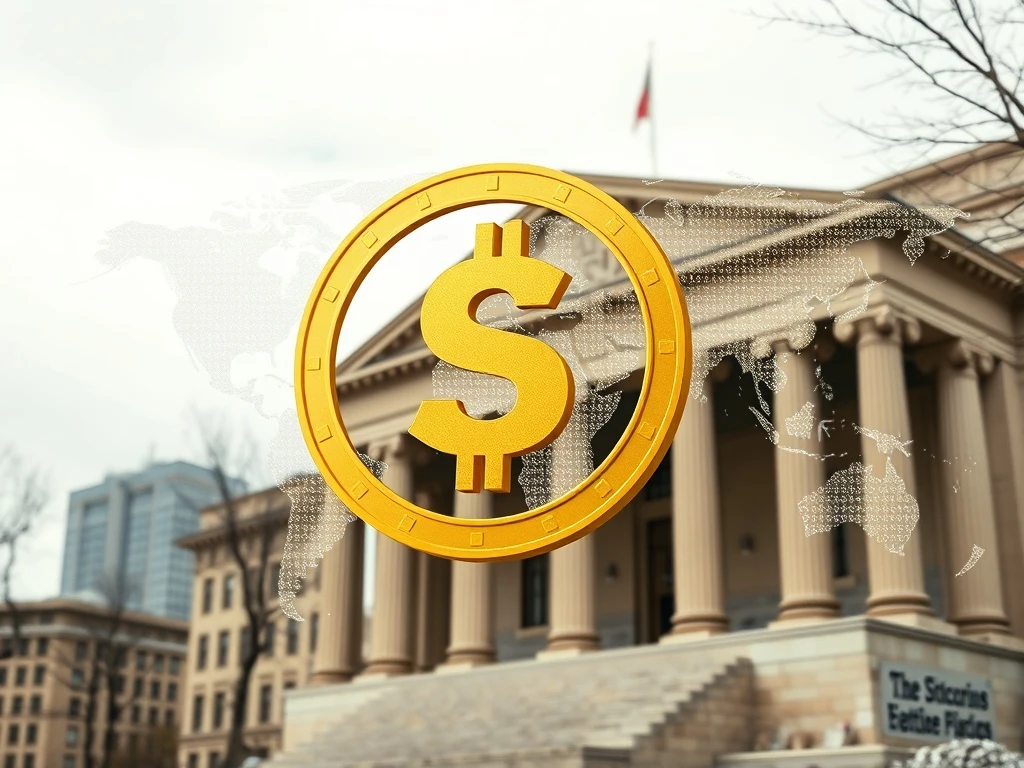Stablecoins: Unleashing Global Dollar Dominance, Not Bank Ruin, Says Coinbase

The debate surrounding stablecoins and their potential impact on traditional finance intensifies. US banking groups voice significant concerns, fearing an exodus of crypto deposits and a destabilization of the financial system. However, Coinbase offers a starkly different perspective, arguing these fears “ignore reality.” The leading cryptocurrency exchange suggests that stablecoins primarily bolster the digital dollar‘s global reach, rather than competing directly with US banks. This counter-narrative challenges conventional thinking, highlighting the unique utility and international demand for these digital assets.
Coinbase Challenges US Banks’ Stablecoin Fears
US banking associations have recently urged Congress to implement stricter regulations on stablecoin yields. They contend that offering yield on stablecoins could draw customers away from traditional banking accounts. This, they argue, would trigger substantial outflows of crypto deposits from the US banks. Consequently, these groups advocate for a clampdown on services providing such yields.
Coinbase researchers, however, strongly dispute this narrative. Faryar Shirzad, Coinbase’s policy chief, stated, “The ‘stablecoins will destroy bank lending’ narrative ignores reality.” He shared a market note further elaborating on this position. The note suggested that worries about stablecoins impacting bank deposits and lending echo past concerns over innovations like money market funds. Yet, these arguments often fail to consider the actual usage patterns of stablecoins.
Global Demand Drives Stablecoin Growth, Not Domestic Competition
A crucial point in Coinbase’s argument is the origin of stablecoin demand. The company asserts that most demand comes from international users. These individuals actively seek exposure to the US dollar. Stablecoins therefore serve as a practical form of dollar access for the underbanked. Moreover, users in emerging markets frequently utilize US dollar stablecoins to hedge against local currency depreciation.
This international focus means stablecoins expand dollar dominance globally. They do not primarily compete with your local US banks. The note emphasized that around two-thirds of all stablecoin transfers occur on decentralized finance (DeFi) or other blockchain platforms. In this context, they function as essential transactional plumbing. This new financial layer runs parallel to the domestic banking system, largely operating outside it.
Digital Dollar: A New Financial Layer Beyond Traditional Banking
Stablecoins essentially represent a digital dollar accessible on global blockchains. They facilitate transactions within a burgeoning new financial ecosystem. Coinbase highlighted that treating stablecoins as a threat misinterprets their role. Instead, they strengthen the dollar’s global standing. They also unlock competitive advantages that the US should actively embrace, not restrict. This perspective reframes the conversation from competition to collaboration and innovation.
Furthermore, the integration of stablecoins into global commerce offers significant benefits. It streamlines cross-border payments. It also provides financial inclusion to populations underserved by traditional banking. This expansion of the digital dollar’s utility on a global scale reinforces its status as the world’s reserve currency. Therefore, fostering stablecoin innovation aligns with long-term US economic interests.
Debunking Community Bank Collapse Myths
Concerns often arise that widespread stablecoin use could severely impact community banks. Coinbase researchers claim these fears also lack solid evidence. They explain that the typical stablecoin user differs significantly from the typical community bank customer. “Community banks and stablecoin holders barely overlap,” Shirzad noted. This distinct user base suggests minimal direct competition for existing crypto deposits.
In fact, Shirzad added that banks could improve their services by integrating stablecoins. This integration might offer new avenues for efficiency and customer engagement. For example, Western Union has already chosen Solana for its stablecoin and crypto network. Such developments indicate a potential for synergy, rather than outright conflict. This progressive view encourages traditional institutions to explore the benefits of digital assets.
Crypto Deposits and the Reality of Market Scale
Forecasts predicting trillions of dollars flowing into stablecoins over the next decade warrant careful examination. Coinbase suggests scrutinizing these projections. Even if stablecoin circulation globally reached $5 trillion, a significant majority of that value would remain foreign-held. It would also be locked in digital settlement systems. This means it would not be diverted from US checking or savings accounts.
The scale of traditional finance further illustrates this point. Commercial bank deposits within the US currently exceed $18 trillion. Therefore, the potential impact of stablecoins on these deposits would remain marginal. Conversely, the global influence of the US dollar would significantly increase. This reality underscores that crypto deposits are unlikely to pose an existential threat to the vast US banking sector.
The Evolving Landscape: Banks Embrace Stablecoins
The regulatory environment for stablecoins is also evolving. The US passed the GENIUS Act earlier this year. This legislation provides a framework for regulating stablecoin service providers. Consequently, multiple large banks and major financial institutions are now launching stablecoin services. Others are actively exploring various offerings. This shift indicates a growing acceptance and integration of digital assets within the established financial system.
This proactive engagement from traditional institutions further supports Coinbase‘s perspective. It suggests that financial leaders recognize the potential benefits of stablecoins. They are moving beyond initial concerns to leverage these innovations. This collaborative approach fosters a more robust and inclusive financial future. It demonstrates that stablecoins can coexist and even enhance traditional banking services.
In conclusion, Coinbase strongly refutes the notion that stablecoins threaten US banks. Instead, the exchange champions stablecoins as powerful tools. They expand the global reach of the digital dollar and offer crucial financial access worldwide. The company’s detailed analysis highlights the distinct user base and international demand. It also emphasizes the marginal impact on domestic crypto deposits. As the financial landscape continues to evolve, embracing stablecoins could unlock new opportunities for innovation and global economic leadership.








